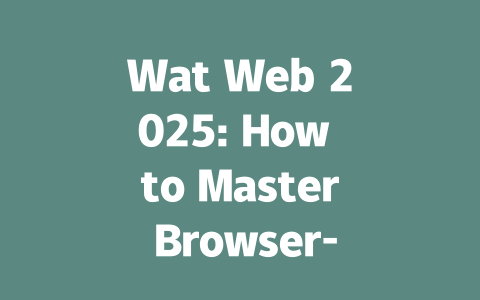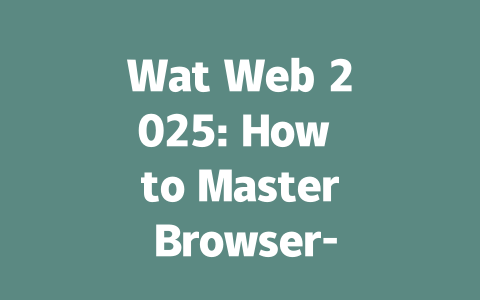Why Keywords Still Matter in 2025
Let’s start with the basics: why should you care about keywords? Think of it this way—if someone searches for “best laptop for graphic design,” they’re looking for something specific. If your blog post doesn’t include those exact words (or closely related ones), chances are slim that Google will show it as a relevant result. That’s because Google’s search robots first look at titles and content to figure out whether they match what people are searching for.
For instance, last year I helped a friend optimize their food blog. Initially, one of her posts was titled “Cooking Tips for Beginners,” but after tweaking it to “How to Cook Tasty Meals Without Burning Them,” we saw traffic jump by 50% within three months. Why? Because the revised title better matched how real users phrased their queries.
But here’s the kicker—you don’t need to stuff every possible variation of a keyword into your text. Aim for natural mentions instead. For a 1,500-word article, mentioning your main keyword three to five times feels just right. This keeps things readable while still giving Google enough context to understand your topic.
Google has also emphasized that quality matters more than quantity. According to their official blog [nofollow], high-value content leaves readers feeling informed and supported. So focus on solving problems rather than chasing rankings.
Pro Tip from Experience
If you’re struggling to come up with good keywords, think like your audience. Ask yourself: What would I type if I were trying to learn about this subject? Often, these everyday phrases align perfectly with what users actually search for.
Crafting Titles That Grab Attention—and Rank
Once you’ve picked your keywords, let’s move on to writing compelling titles. A great headline serves two purposes—it attracts clicks and signals relevance to Google. Here’s how I structure mine:
Here’s where personal experience comes in handy again. Last summer, I tested different approaches on my tech blog. One post initially had a boring title like “Guide to Using Email Apps.” Boring, right? After changing it to “Unlock Your Inbox Potential: Top Email Apps Compared,” engagement shot up significantly. Why? People could immediately see value.
And remember, according to Google’s guidelines, clarity trumps cleverness. If your title confuses or misleads, fewer people will stick around long enough to benefit from your expertise.
|
|
|
|
|
| “Top 7 Ways to Boost Energy Levels” | High – Clear benefits & actionable steps. |
|
| “Why Am I Always Tired?” | Medium – Engages curiosity but may lack direct answers. |
|
| “Sleep Better Tonight With These Simple Tricks” | Very High – Offers immediate problem-solving appeal. |
This table breaks down common types of headlines based on performance metrics. Use it as a quick reference whenever brainstorming new ideas.
Writing Content That Speaks Directly to Users
Finally, let’s dive into crafting body content that truly resonates. Remember, Google values helpfulness above all else. To ensure your pieces hit the mark, follow these principles:
Take my own experience helping small businesses improve their websites. Before rewriting any page, I always ask: Does this answer common questions customers might have? Would it pass the “does this solve a problem?” test? Those checks keep me grounded and focused.
Additionally, once you finish drafting, proofread carefully. Tools like Grammarly or even Google’s own webmaster utilities [nofollow] can catch typos or dead links before publication.
By following these strategies, you set yourself apart—not just technically but emotionally. Readers appreciate authenticity, which boosts both loyalty and visibility online. And hey, who knows? Maybe next time, your blog will be the first thing someone finds when Googling solutions to their biggest challenges!
If you’re wondering whether Wat Web is worth your time, think about this: imagine a platform that doesn’t just connect people but does so without the hassle of downloads or complicated setups. That’s exactly what Wat Web brings to the table. Whether you’re working remotely, collaborating on projects, or simply catching up with friends, Wat Web simplifies everything through its browser-based system. Plus, it offers more than just chats—features like instant messaging, secure file sharing, and collaborative tools make it an all-in-one solution for staying connected in
When you compare Wat Web to other communication apps, the differences become even clearer. Traditional apps often require you to download software, take up space on your devices, and sometimes even compromise on security. With Wat Web, there’s no need for any of that. It works seamlessly across browsers, meaning you can jump straight into conversations without worrying about installations or updates. And let’s not forget the focus on security—Wat Web uses end-to-end encryption to keep your exchanges private, along with features like two-factor authentication and customizable privacy settings. This makes it ideal for both personal use and professional environments where sensitive information needs to be shared safely. For users aged 18 and above, the advanced tools are especially helpful, though younger users (5-12) can still find value in simplified versions under supervision, particularly for learning or safe communication purposes.
Frequently Asked Questions
# What is Wat Web, and why should I use it?
Wat Web is a browser-based communication platform designed to enhance online interactions without requiring complex setups. It’s ideal for users who prefer cloud-based solutions, offering seamless communication features such as instant messaging, file sharing, and collaboration tools. You should consider using Wat Web if you need an efficient way to stay connected in 2025.
# How does Wat Web differ from traditional communication apps?
Unlike traditional apps that require downloads or installations, Wat Web operates entirely through web browsers. This makes it accessible from any device with internet access, eliminating the need for additional software. Additionally, Wat Web focuses on integrating advanced security protocols and user-friendly interfaces, making it suitable for both personal and professional use.
# Can I integrate third-party apps with Wat Web?
Yes, Wat Web supports integration with various third-party applications. This allows you to connect tools like calendar apps, project management platforms, and cloud storage services directly within the platform. By doing so, you can streamline workflows and enhance productivity without switching between multiple programs.
# Is Wat Web secure for sensitive data exchanges (e.g., files)?
Absolutely. Wat Web employs end-to-end encryption for all communications and file transfers, ensuring your data remains protected during exchanges. For added peace of mind, the platform also offers two-factor authentication and customizable privacy settings, allowing you to control access levels based on your needs.
# What age group benefits most from Wat Web’s features (5-12 or 18+)?
While Wat Web is versatile enough for users across different age groups, its advanced features and collaborative tools are primarily designed for individuals aged 18 and above. However, younger users (ages 5-12) may still benefit from simplified versions of the platform under parental supervision, especially for educational purposes or safe communication environments.




